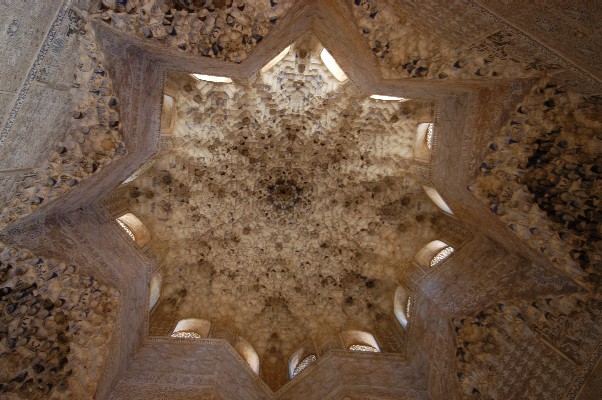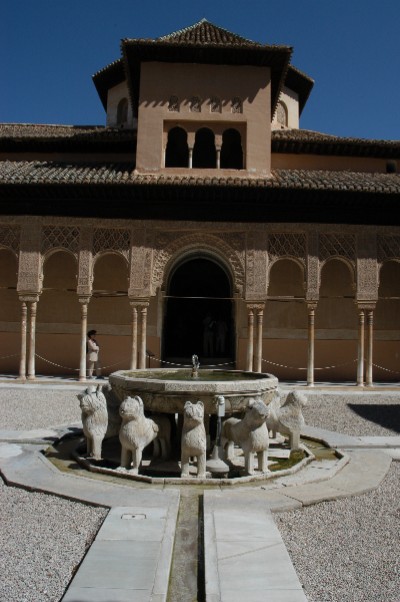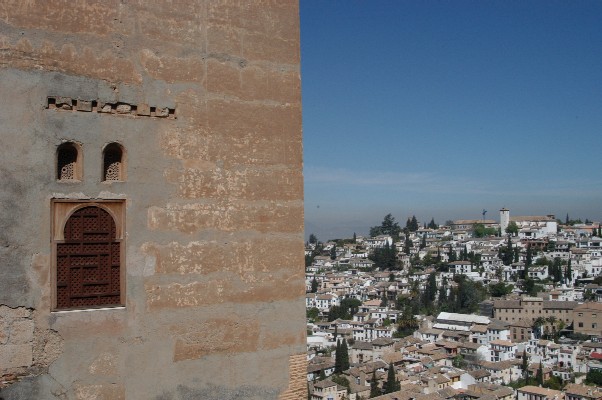THE ALHAMBRA "Part Two" The artisans rejected the use stone in architecture and instead favored brick, wood, or gesso because the materials allowed air to flow through which eliminated dampness. The stucco was made from gypsum and pulverized marble and could be shaped into various delicate shapes that represented nature (flowers and shells) and religious cosmology (stars and heavens). All of these shapes were done in the same continuous style and each had meaning. The shell shapes were symbolic of water, the creator of life. Calligraphy, Islam's most respected art form, was woven amongst the shapes, quoting the Quran.
 Even with hoards of people crammed into the first room of the Mexuar Palace and the mummer of tour guides giving their spiel it was impossible not to be impressed. This was the oldest part of the Palaces but had also suffered the most alteration. It was here where the council met and the Islamic script read "Enter and ask. Do not be afraid to seek justice for here you will find it." On the far side overlooking the Albayzin was a small oratory, apparently a reconstruction, that faced Mecca and would have provided a place for the council to make their daily prayers. The council room opened up to a narrow porch that led into a small courtyard centered around a fountain. Unlike the towering fountains of European design this fountain just barely sat above the marble pavement. And, instead of water splashing loudly into the bowl, only a trickle of water gurgled out of the middle of the large flower shaped dish. The soft sound of the water was meant to be more conducive to meditative thinking. Even with hoards of people crammed into the first room of the Mexuar Palace and the mummer of tour guides giving their spiel it was impossible not to be impressed. This was the oldest part of the Palaces but had also suffered the most alteration. It was here where the council met and the Islamic script read "Enter and ask. Do not be afraid to seek justice for here you will find it." On the far side overlooking the Albayzin was a small oratory, apparently a reconstruction, that faced Mecca and would have provided a place for the council to make their daily prayers. The council room opened up to a narrow porch that led into a small courtyard centered around a fountain. Unlike the towering fountains of European design this fountain just barely sat above the marble pavement. And, instead of water splashing loudly into the bowl, only a trickle of water gurgled out of the middle of the large flower shaped dish. The soft sound of the water was meant to be more conducive to meditative thinking.
Across the courtyard was the entrance to the Comares Palace, marked by two doors set into a wall of more ornate arabesque work. The detail extended all of the way up to the wooden overhangs that were also carved. The windows were surrounded with the phrase "The only Conquerer is God", the motto of the Nasarid Dynasty. The right door was closed but would have once been for the exclusive use of the royal family while the left was for everyone else. We entered through the left door which led us through two quick left turns and into the Courtyard of the Myrtles. through the left door which led us through two quick left turns and into the Courtyard of the Myrtles.
The Courtyard of the Myrtles was named after the myrtle hedge that surrounds the long narrow reflecting pool. Myrtle was used because it is evergreen and when two leaves are rubbed together they give off a pleasant smell. The long glass pool gracefully reflected the palace facades at either end. It was this very design that would be used for India's Taj Mahal, three centuries after the Nasarid Palace was built. This was also another design with Islamic symbolism. The reflecting the pool made the palace whole. In the Islamic analogy the palace is like God, real and enduring, while humans are like the pool, just God's reflection, weak, mortal and deceptive. White marble bowls quietly poured water into the pool from either end. White marble floors covered the palace floors and courtyard. Together the water and marble provided a cooling effect and gave off serenity.
On the northern end of the courtyard, overlooking Granada stood the enormous Comares Tower. From the city it just looked like a military tower with only the small latticed windows giving a hint to the ornate display inside. The Comares Tower housed the Hall of the Boat, a narrow room with a wooden ceiling in the shape of an upturned boat. This hall led to the large Hall of the Ambassadors, or throne room, where the emirs would have received important people, including Christian emissaries. Inscriptions on the wall reflected the public nature of the room, "Be brief and leave in peace." Lattice windows allowed delicate light to fill the once colorful room. The colorfully tiled and arabesque filled walls joined the square marble floor with the a spectacular wooden ceiling, made of 9017 separate pieces of wood. The design formed seven concentric circles which represented the seven heavens of Islam. These seven heavens are believed to  lie between the flat earth and paradise, where the roots of the tree of life sustained all of the stars and galaxies. This is based on the legendary visit that the Prophet Mohammed made to heaven on a white horse, accompanied by the Archangel Gabriel. The first heaven was made of emeralds, the second of red pearls, the third or rubies, the fourth of white silver, the fifth of gold, the sixth of white pearls, and the seventh of brilliant light. These colors were once reflected in the ceiling, walls and windows of the great hall. During restoration work a small wooden peg was found protruding from the ceiling with a kind of painter's crib sheets inscribed on it to maintain the colors of the ceiling but this kind of restoration work has not been done. This architecture which appears so elegantly white and simple was once an explosion of colors. The heavens in the wooden ceiling had color, the arabesque stucco had color and the windows were once filled with stained glass. Today just the tiling maintains its vibrant color. lie between the flat earth and paradise, where the roots of the tree of life sustained all of the stars and galaxies. This is based on the legendary visit that the Prophet Mohammed made to heaven on a white horse, accompanied by the Archangel Gabriel. The first heaven was made of emeralds, the second of red pearls, the third or rubies, the fourth of white silver, the fifth of gold, the sixth of white pearls, and the seventh of brilliant light. These colors were once reflected in the ceiling, walls and windows of the great hall. During restoration work a small wooden peg was found protruding from the ceiling with a kind of painter's crib sheets inscribed on it to maintain the colors of the ceiling but this kind of restoration work has not been done. This architecture which appears so elegantly white and simple was once an explosion of colors. The heavens in the wooden ceiling had color, the arabesque stucco had color and the windows were once filled with stained glass. Today just the tiling maintains its vibrant color.
The Mocarabes, a honeycomb design, was a common theme throughout the Nasarid Palaces. It was meant to symbolize the stalactites from the cave where Mohammed sought safety from his enemies while en route to Mecca. The stucco pieces with triangular sections can be joined in various ways to create convex or concave structures. In the palaces it provided transitional accents between pillars and arches, and between walls and ceilings. It allowed a square room to transition into a hemispherical cupola. The square represented earthly elements while the cupola represented the sky or air. 
Along with the arabesque stucco work, mocarabes, and the use of water and marble, mosaic and alticado tiling were important stylistic elements used throughout the palaces. The mosaic tile work referred to one or more repeated elements while alticado tiling created layers of optical perception. Looking closely it has one layer but as you move away you see other designs emerge from the layers of smaller ones. It was this feature that influenced the Dutch artist, Escher. All of these stylistic elements served to perpetuate a basic ornamental code which gave the palaces a repetitive rhythm. All of the motifs were infinitely repetitive, a metaphor for eternity. The concept of multiplicity makes whole. |
SPAIN
Madrid
Mar 23
Mar 24
Mar 25-26
Mar 27-30
Granada
Mar 31
April 1-28
Semana Santa
Part I
Part II
Photos I
Photos II
Photos III
Photos IV
The Alhambra
Part I
Part II
Part III
Part IV
GIBRALTAR
April 29
MOROCCO
Chefchaouen
April 30
May 1
Fes
May 2
May 3
May 4
May 5
May 6
Meknes
May 7
May 8
May 9
Sahara
May 10-11
May 12
May 13-14
May 15
Marrakesh
May 16
|

